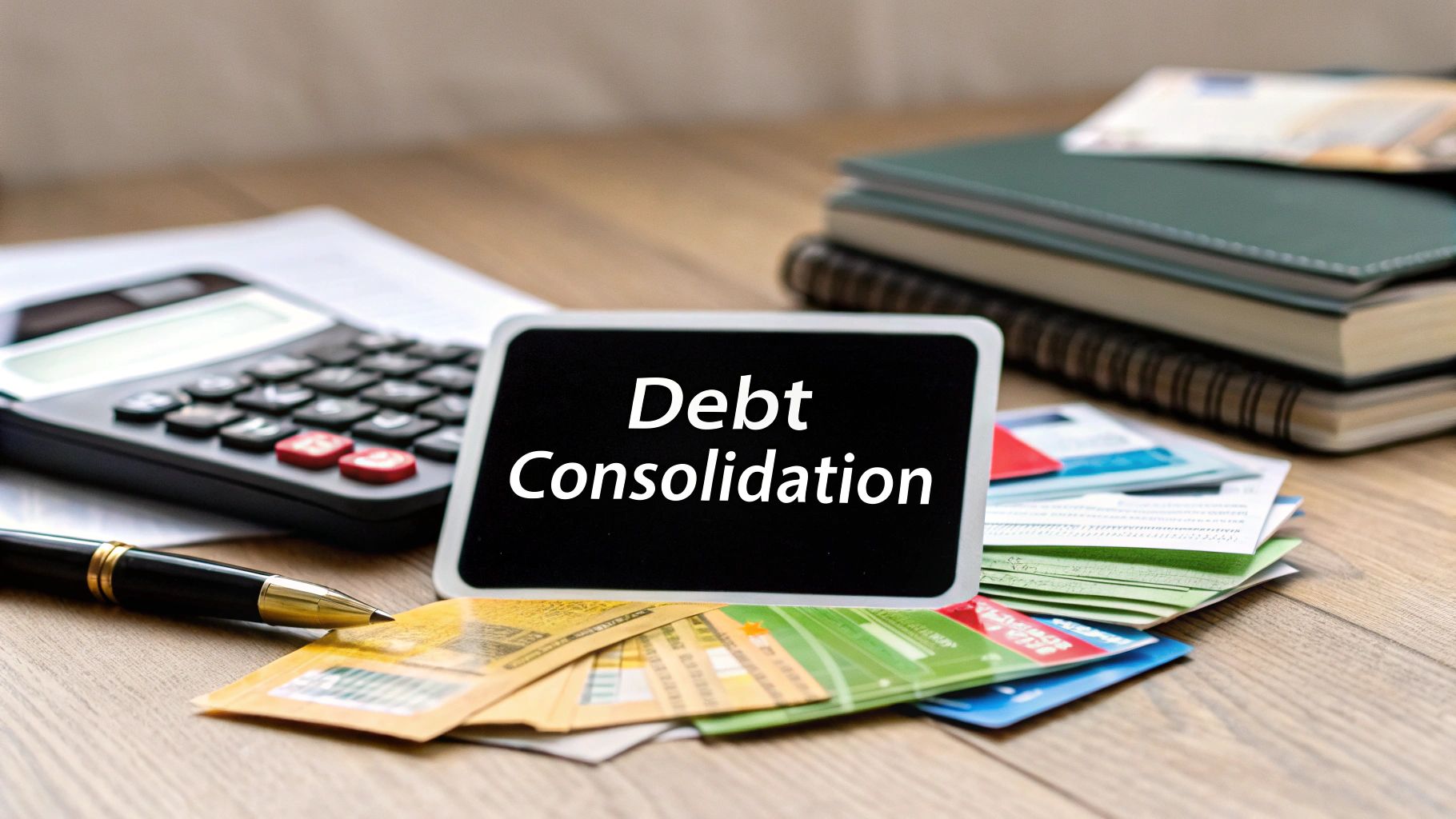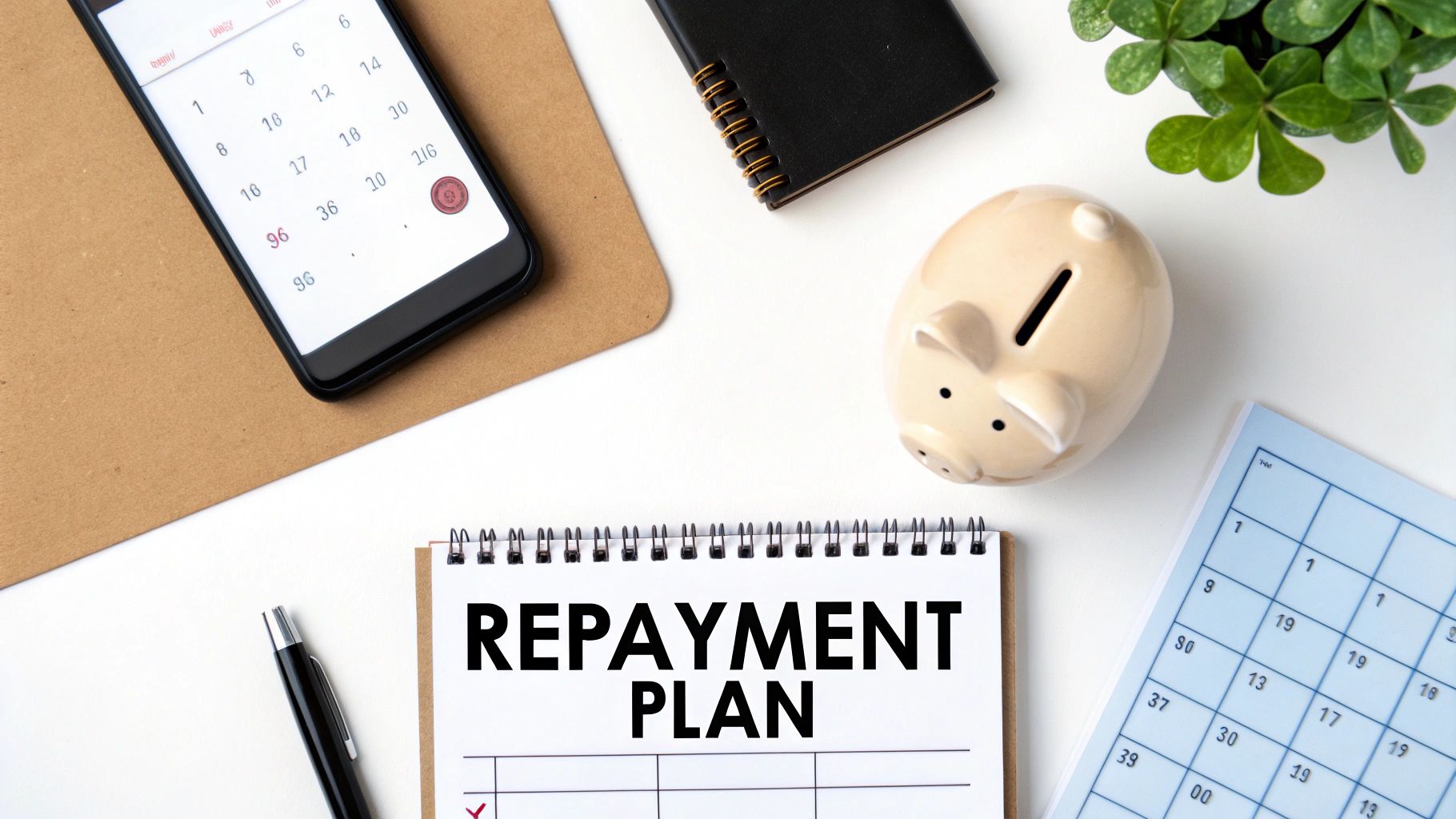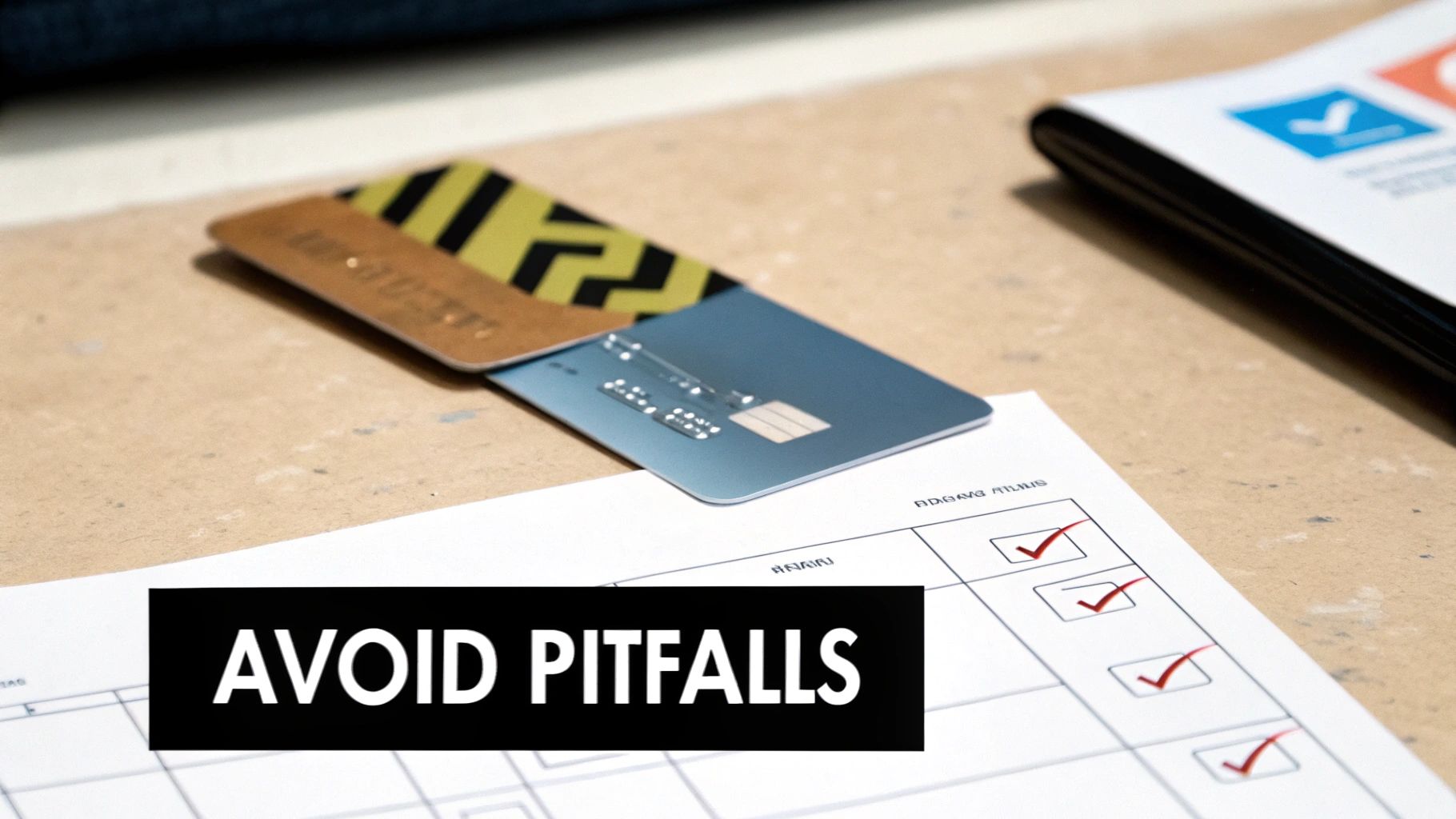A Guide to Consolidating Credit Card Debt

If you're feeling weighed down by a stack of credit card bills, you're not alone. The idea behind consolidating your credit card debt is simple: you combine all those high-interest balances into a single, more manageable loan. The goal is to get a lower interest rate, which simplifies your life with just one monthly payment and can save you a ton of money on interest. Ultimately, it can help you get out of debt much faster.
Understanding When Consolidation Is a Smart Move
Juggling a handful of credit card payments every month isn't just a headache—it’s expensive. High interest rates often make you feel like you're on a financial treadmill, making payments but never actually getting ahead. It's a common story, especially when rising costs make relying on credit a necessity.
The scale of this issue is massive. Total U.S. credit card debt has ballooned to around **1.2 trillion**, with the average household owing about 15,000. These aren't just numbers; they represent millions of people looking for a way out.
Think of debt consolidation as a strategic financial reset. You’re trading a chaotic mess of due dates, minimum payments, and sky-high APRs for one clear, predictable payment. This shift alone can bring huge psychological relief, freeing you up to focus on your actual financial goals instead of just trying to stay afloat.
Signs That Consolidation Is Right for You
So, how do you know if this is the right move for you? There are a few clear signs that you're a perfect candidate for consolidation. If these points resonate with you, it's a good indication this strategy could be a game-changer.
When to Reconsider Consolidation
On the flip side, consolidation isn't for everyone. In some situations, it might not help, and in others, it could even make things worse.
If your total debt is fairly small and you think you can realistically knock it out in a year or so with a focused strategy (like the debt snowball or avalanche), then the fees and hassle of a new loan might not be worth it.
It also comes down to the math. If your credit score is too low to get a new loan with a better interest rate than you're already paying, consolidation simply won't save you any money. And most importantly, if you haven't addressed the root cause of your spending, you could easily max out those old credit cards again, leaving you with the new loan and new credit card debt. That's a recipe for disaster.
For entrepreneurs facing similar financial hurdles with their companies, the right approach can be a bit different. It's smart to look into guides on debt consolidation specifically for small businesses to understand the unique options available.
Finding Your Best Debt Consolidation Path
Okay, so you've decided consolidating your credit card debt is the way to go. That's a huge first step. Now comes the tricky part: picking the right tool for the job.
This isn't a one-size-fits-all situation. The best method for you hinges on a few key things: how much you owe, what your credit profile looks like, and how disciplined you are with your finances. Let's walk through the most common options to figure out which one fits you best.
This decision tree gives you a quick visual to start mapping out your options.

Ultimately, choosing to consolidate is about taking back control. Let's make sure you pick the path that gets you there.
The Personal Loan Advantage
For many people, a personal loan is the workhorse of debt consolidation, especially for larger balances. It’s pretty straightforward: you get a lump-sum loan from a bank, credit union, or online lender, and you use that cash to wipe out all your credit card balances.
What you're left with is one single loan. One monthly payment. One interest rate. The beauty of this is predictability. Most personal loans have a fixed interest rate and a fixed monthly payment, so you know exactly how much you'll pay and for how long—usually two to seven years. No more guessing games.
This predictability is a game-changer when you look at the numbers. The average APR on credit cards charging interest is a staggering 22.83%. Compare that to the average personal loan rate for consolidation, which sits around 11.14%. If you have decent credit and a good chunk of debt, that difference can literally save you thousands of dollars.
Leveraging a Balance Transfer Card
A balance transfer card attacks the problem from a different angle: a 0% introductory APR period. These offers usually run for 12 to 21 months, giving you a golden opportunity to chip away at your principal debt without interest working against you.
This is a fantastic strategy for smaller, more manageable debt. Let's say you owe 5,000**. If you get a card with an 18-month 0% APR deal, you’d need to pay about **278 a month to have it cleared before the regular interest rate kicks in.
But you have to be careful. There are a few catches:
Using Home Equity A Potent but Risky Option
If you're a homeowner, you might be tempted by a home equity line of credit (HELOC). Because your house is the collateral, these secured loans often have the lowest interest rates you can find, making them a powerful way to consolidate huge amounts of debt.
A HELOC acts a bit like a credit card. You get a line of credit to draw from, and for the first several years (the "draw period"), your payments might be interest-only, which keeps them low.
Here’s the massive risk: you're putting your home on the line. If you hit a rough patch and can't make the payments, the lender can foreclose. This isn't just a ding on your credit report; it's losing your home. Plus, most HELOCs have variable interest rates, meaning your payments could jump up unexpectedly.
For a clearer look at how these stack up, here’s a quick comparison.
Comparing Debt Consolidation Methods
This table breaks down the key differences between the most common consolidation strategies, helping you see which one might be the right fit for your situation.
Each path has its place, but it's crucial to match the solution to your specific problem and risk tolerance.
A HELOC should only ever be on the table if your income is rock-solid and you have a significant financial safety net. To learn more about the fundamentals, our guide on what debt consolidation is is a great place to start. For most people trying to get out from under credit card debt, the unsecured nature of a personal loan makes it a much smarter and safer choice.
How to Qualify and Apply for Consolidation
So, you're ready to tackle that credit card debt. Good. Turning that plan into action means first getting a clear picture of your finances from a lender's perspective. Before they'll hand over a consolidation loan, they need to feel confident you can handle it. This really boils down to two key numbers they'll zero in on.
The first is your credit score. Think of it as your financial reputation boiled down to a single, three-digit number. It’s a quick way for lenders to see how you've managed money in the past. A higher score often opens the door to much better interest rates. For most consolidation loans, a score of 670 or higher is the sweet spot that will get you the most competitive offers.
The second number that matters is your debt-to-income (DTI) ratio. This little percentage tells lenders how much of your monthly income is already spoken for by existing debt payments. If that number creeps too high, it's a red flag for them. It suggests you might be stretched too thin to comfortably add another payment to the mix.
Assessing Your Financial Readiness
Before you even think about filling out an application, you need to do a little homework on your own numbers. This isn't just busywork—it's about walking into the conversation with a lender knowing exactly where you stand. It puts you in a much stronger position.
First, pull your credit score. You can usually get it for free from your bank or a credit monitoring service. While you're at it, comb through your credit report. Are there any mistakes? An account you don't recognize or a payment incorrectly marked as late? Disputing these errors can sometimes give your score a nice little bump.
Next up, it's time to figure out your DTI. You'll add up all your monthly debt payments—things like rent, car payments, and the minimums on your credit cards. Then, you divide that total by your gross monthly income. For a step-by-step guide, check out our article on how to calculate your debt-to-income ratio. Lenders really like to see a DTI below 43%.
With these two numbers in hand, you'll have a solid understanding of your financial health and a realistic idea of what kind of loan offers to expect.
Gathering Your Application Documents
Okay, you know your numbers. Now it's time to get your paperwork in order. Having all your documents ready before you apply makes the whole process faster and way less stressful. You're essentially building a portfolio that proves you’re a great candidate.
Here’s a quick checklist of what you'll almost certainly need:
My advice? Scan these and save them in a digital folder on your computer. When you're filling out online applications, you can just upload them in seconds instead of scrambling to find everything.
Comparing Offers and Avoiding Hidden Costs
This is where the real work begins—and where you can save yourself a lot of money. Never, ever take the first loan offer you get. Banks, credit unions, and online lenders are all competing for your business, and their terms can be wildly different.
Start by getting pre-qualified with at least three to four different lenders. Pre-qualification uses a "soft" credit check, which does not hurt your credit score, and it gives you a real-world preview of the rates and loan amounts you can expect.
As the offers start rolling in, don't just fixate on the monthly payment. You have to dig into the fine print to spot the traps that could make your "good deal" a lot more expensive down the road.
Watch out for these three things:
By methodically comparing these key details, you can confidently pick the loan that actually saves you the most money and helps you become debt-free sooner.
Building a Repayment Plan That Actually Works

Landing a debt consolidation loan feels like a massive victory, and it absolutely is. But think of it as the starting line, not the finish. The real win comes from building a repayment strategy that not only clears the loan but also breaks the cycle of debt for good. This is where you shift from just managing numbers to building lasting financial habits.
Your mindset is everything here. The hard truth is that this is where many people stumble. A recent study showed that 46% of American credit cardholders were carrying balances from one month to the next. What's even more telling? Less than half of them—just 48%—had an actual plan to pay it down. This points to a huge problem: feeling overwhelmed often leads to inaction. A clear, actionable plan is what will set you apart.
This is your chance to build a totally new financial future, one where you're calling the shots.
Automate Your Success
The single most effective way to stick to your repayment plan is to put it on autopilot. Life happens. Things get busy, and it's all too easy for a due date to slip your mind. Setting up automatic payments takes that risk completely off the table.
Schedule your new loan payment to be debited from your checking account a day or two after your paycheck hits. It’s the classic "pay yourself first" principle in action. This simple move ensures your most important financial goal is handled before that money can be spent elsewhere. It makes your commitment a non-negotiable part of your monthly budget.
Don't just stop at the minimum payment, either. Think about the impact of paying a little extra. Even an additional 25 or 50 a month can chip away at your principal balance surprisingly fast. This reduces the total interest you'll pay and can shave months—or even years—off your loan.
Resisting the Temptation of Empty Cards
This is the most common pitfall I see people encounter after consolidating their credit cards. They look at their old cards, see those beautiful zero balances, and slowly start swiping again. This is the fastest way to reverse all your progress, leaving you with both the new consolidation loan and a fresh pile of credit card debt.
You have to make a conscious decision to change your spending habits. This isn't about depriving yourself; it's about being more intentional with your money.
Here are a few practical ways to do that:
For more powerful strategies that go hand-in-hand with a consolidation loan, our guide on how to pay off credit card debt quickly offers some great tips.
Developing these new habits is the final piece of the puzzle. When you pair your new, simplified loan payment with smarter spending choices, you're not just paying off debt—you're laying the groundwork for real, lasting financial freedom.
Common Pitfalls in Debt Consolidation and How to Avoid Them
Getting your debt consolidated is a fantastic first step, but it’s just that—a first step. The road to being debt-free has a few common potholes that can easily derail all your hard work. Knowing what they are ahead of time is the best way to steer clear and keep your financial plan on track.

I’ve seen it happen too many times. People get so focused on just getting the loan approved that they miss the subtle details that end up costing them dearly. Learning from those common missteps can save you a world of time, money, and stress.
The Low Payment, Long-Term Trap
It’s so tempting to jump at the loan with the lowest monthly payment. On the surface, it looks like the smartest move for your budget. But this usually means you’re signing up for a much longer repayment term, maybe stretching a 3-year debt into a 5- or 7-year marathon.
While that smaller payment brings immediate relief, it's often a costly illusion. A longer term means more time for interest to pile up. Over the life of the loan, you could easily pay hundreds, if not thousands, of dollars more than you would have with a shorter term, even with a decent interest rate.
Before you sign anything, calculate the total interest you'll pay for each option. This simple reality check helps you make a decision based on the true cost, not just what feels easier today.